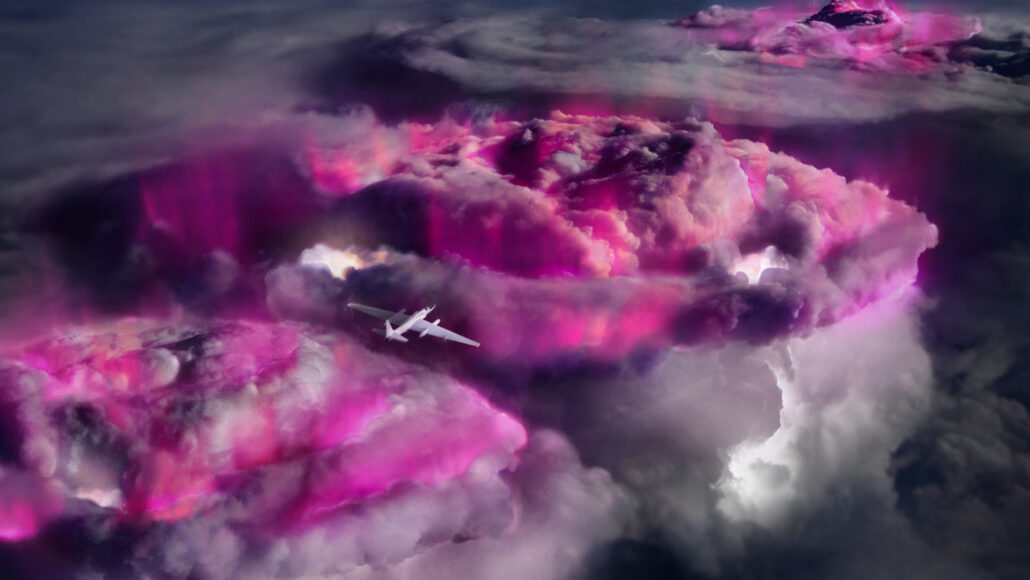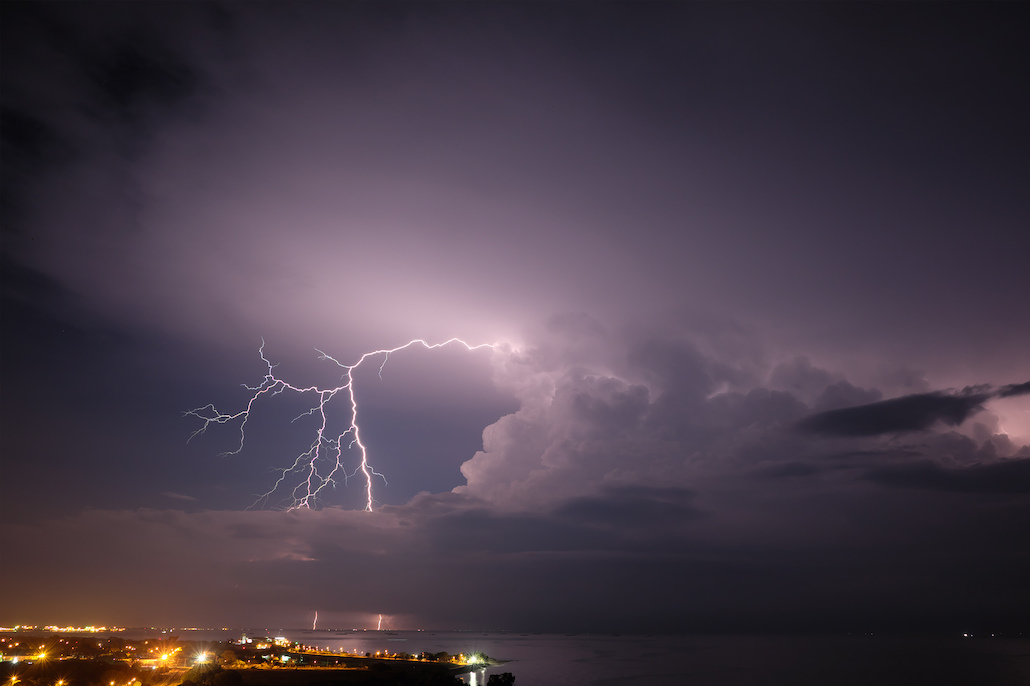Thunderstorms churn up a ‘boiling pot’ of high-energy gamma rays
Views from a NASA plane have just shed new light on these invisible bursts of radiation

A thunderstorm, viewed from an airplane soaring above the clouds, glows in gamma rays. They’re purple in this illustration, but invisible to the human eye.
The ALOFT team/Mount Visual (CC BY 4.0)
Above the cloud tops, thunderstorms throb with a complex, frenzied light show. But these bright flashes cannot be seen with the eye. They give off a type of invisible, high-energy light known as gamma rays.
NASA’s ER-2 aircraft has now offered new views of this radiation shimmering above thunderstorms. During 10 flights, the plane captured gamma-ray outbursts with different durations and intensities. And the results have scientists feeling electrified.
For one thing, it appears that two known types of storm-powered gamma rays are more complex — and common — than scientists had thought. The new data also have unveiled a never-before-seen type of blast. It’s called a flickering gamma-ray flash.
“I’m absolutely awestruck,” says David Smith. He’s a physicist at the University of California, Santa Cruz, who was not involved with the research. The new findings are the most important data in this field in more than a decade, he says.
Spying on storms
The ER-2 plane soared over storms in the Caribbean and Central America in July 2023. It cruised at an altitude of about 20 kilometers (12.4 miles). That’s roughly twice as high as commercial flights. Up there, the aircraft had a front-row seat to storm clouds’ gamma-ray fireworks.
The plane was also rigged to send data to the ground in real time. That allowed researchers to send the pilot back to regions found to be hopping with gamma rays.
Before this study, scientists knew about two main types of storm-made gamma rays. One type are terrestrial gamma-ray flashes. These short, intense blasts are so bright that they can be seen from space. Each one lasts less than a thousandth of a second. The other known type are called gamma-ray glows. These emissions are dimmer but last longer.
The ER-2 plane made new discoveries about both types.

Gamma-ray glows turned out to be surprisingly long-lived and common. Storms could glow for hours. And the glow could span thousands of square kilometers (hundreds or thousands of square miles). The plane measured this type of emission on nine of its 10 flights. Nikolai Østgaard and his colleagues described these findings October 3 in Nature.
“It’s astonishing,” says Ningyu Liu. This physicist at the University of New Hampshire in Durham did not take part in the new work.
What’s more, gamma-ray glows weren’t as stable as scientists had thought. Instead, these lights repeatedly brightened and dimmed over the course of seconds.
“Large storms are bubbling. It’s like a boiling pot,” says Østgaard. He’s a physicist at the University of Bergen in Norway.
The flights also found many terrestrial gamma-ray flashes too dim to be seen from space. This hints that past satellite data missed many of these flashes — which would appear to make them more common that scientists had thought. Østgaard and others shared that discovery September 7 in Geophysical Research Letters.
New gamma ray type fills in thunderstorm puzzles
And then there are the newfound flickering gamma-ray flashes. These outbursts fall between the two other types of gamma-ray emissions in both brightness and duration. Like high-energy strobe lights, gamma-ray flickers consist of short pulses that repeat over tens to hundreds of milliseconds. Østgaard and the other researchers described these on October 3 in yet another Nature paper.
Those flickers could help solve a couple key mysteries about thunderstorms. One is: How are their different types of gamma-ray outbursts related?
Storms are known to produce gamma rays when electrons get accelerated in strong electric fields that build up inside clouds. These electrons produce more electrons, and so on. When electrons in this avalanche smash into air molecules, they throw off gamma rays. But it’s still unknown what makes a cloud emit a terrestrial gamma-ray flash, versus a gamma-ray glow.
Discovering a middle ground between those two extremes — those flickering gamma-ray flashes — could help answer that question.
The flickering ones may help explain how lightning forms, too. Many of the flickering gamma-ray flashes seen by ER-2 were followed by lightning. This could mean that the flickering gamma-ray flashes help kickstart those bolts.
Gamma rays might help limit how strong electric fields can get in thunderclouds, too, says Steven Cummer. He’s an electrical engineer at Duke University in Durham, N.C., who worked with Østgaard. “This whole gamma ray–generating process [seemed] interesting and uncommon before,” he says. But it “now actually appears to be quite central in all of atmospheric electricity.”







